Abstract
BACKGROUND: 5-chloro-7-iodo-8-hydroxyquinoline (clioquinol) was used clinically three decades ago as an oral antiparasitic agent and to increase intestinal absorption of zinc in patients with acrodermatitis enteropathica, a genetic disorder of zinc absorption. Use of clioquinol was epidemiologically linked to subacute myelo-optic neuropathy (SMON), characterized by peripheral neuropathy and blindness, which affected 10,000 patients in Japan. Discontinuation of oral clioquinol use led to elimination of SMON, however, the mechanism of how clioquinol induces neurotoxicity is unclear. MATERIALS AND METHODS: We tested the effect of clioquinol-metal chelates on neural crest-derived melanoma cells. The effect of clioquinol chelates on cells was further studied by electron microscopy and by a mitochondrial potential-sensitive fluorescent dye. RESULTS: Of the ions tested, only clioquinol-zinc chelate demonstrated cytotoxicity. The cytotoxicity of clioquinol-zinc chelate was extremely rapid, suggesting that its primary effect was on the mitochondria. Electron microscopic analysis demonstrated that clioquinol-zinc chelate caused mitochondrial damage. This finding was further confirmed by the observation that clioquinol-zinc chelate caused a decrease in mitochondrial membrane potential. CONCLUSIONS: We demonstrate that clioquinol, in the presence of zinc, is converted to a potent mitochondrial toxin. The phenomenon of clioquinol mediated toxicity appears to be specific to zinc and is not seen with other metals tested. Since clioquinol has been shown to cause increased systemic absorption of zinc in humans, it is likely that clioquinol-zinc chelate was present in appreciable levels in patients with SMON and may be the ultimate causative toxin of SMON.
Full text
PDF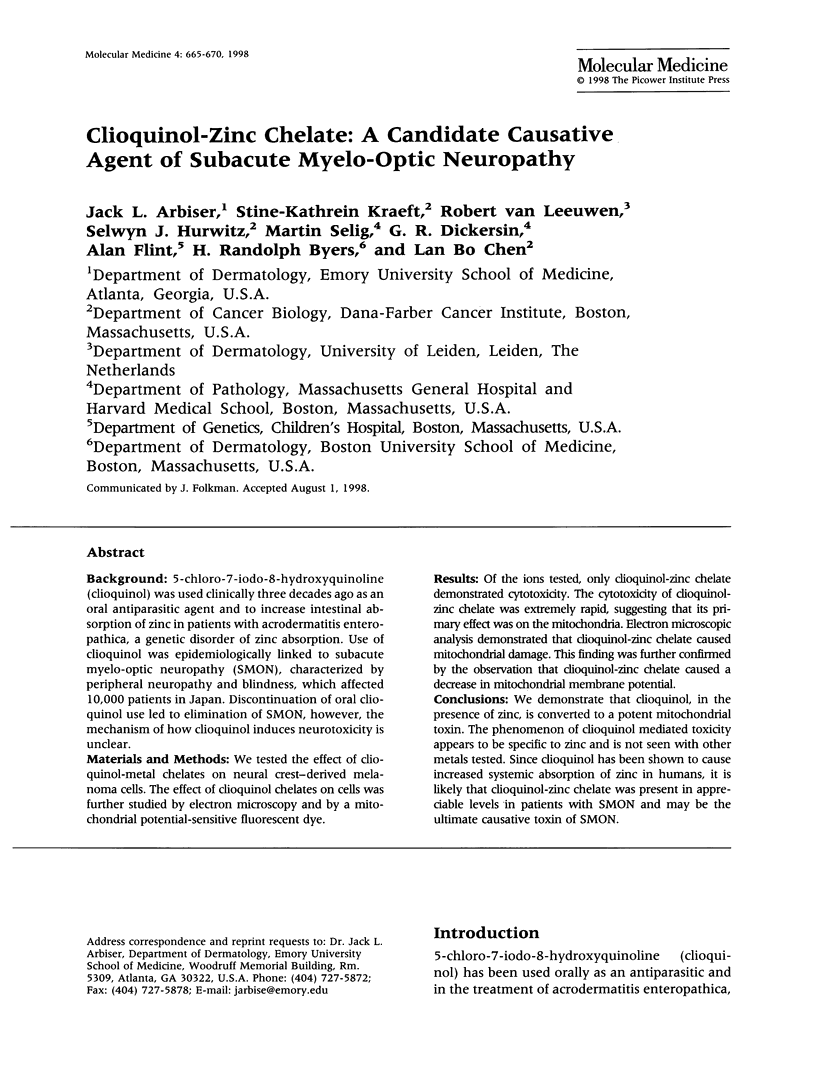
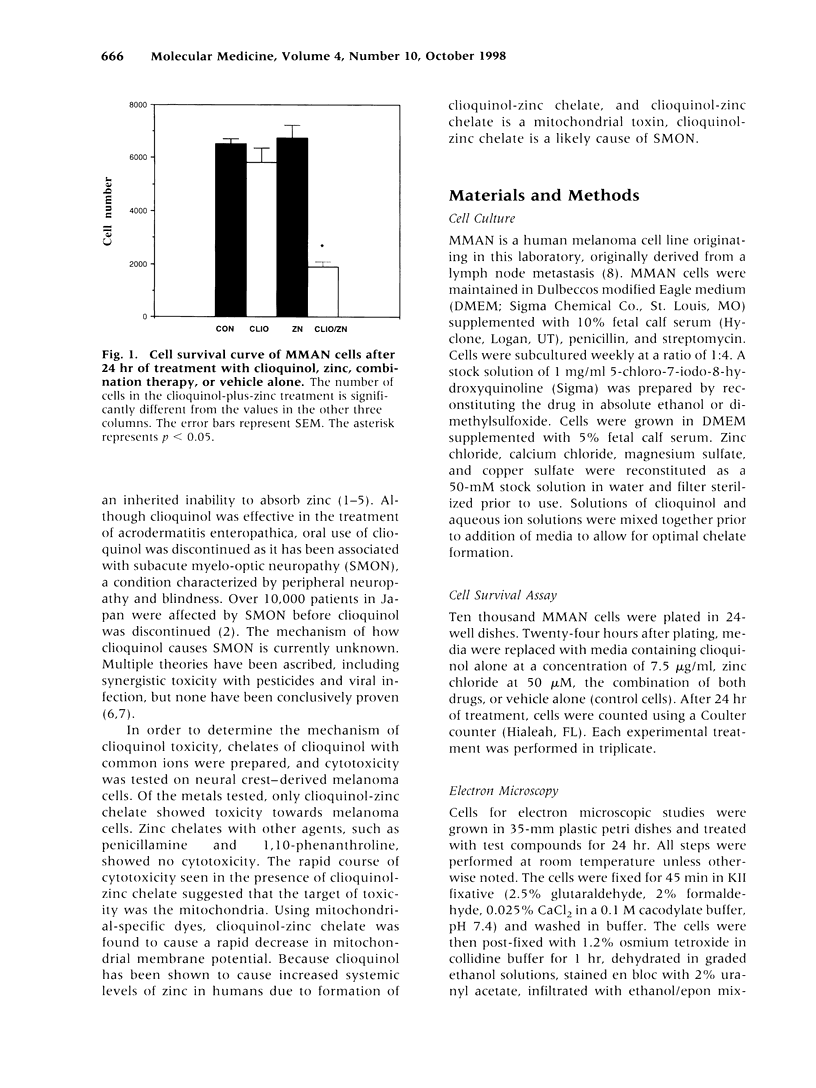
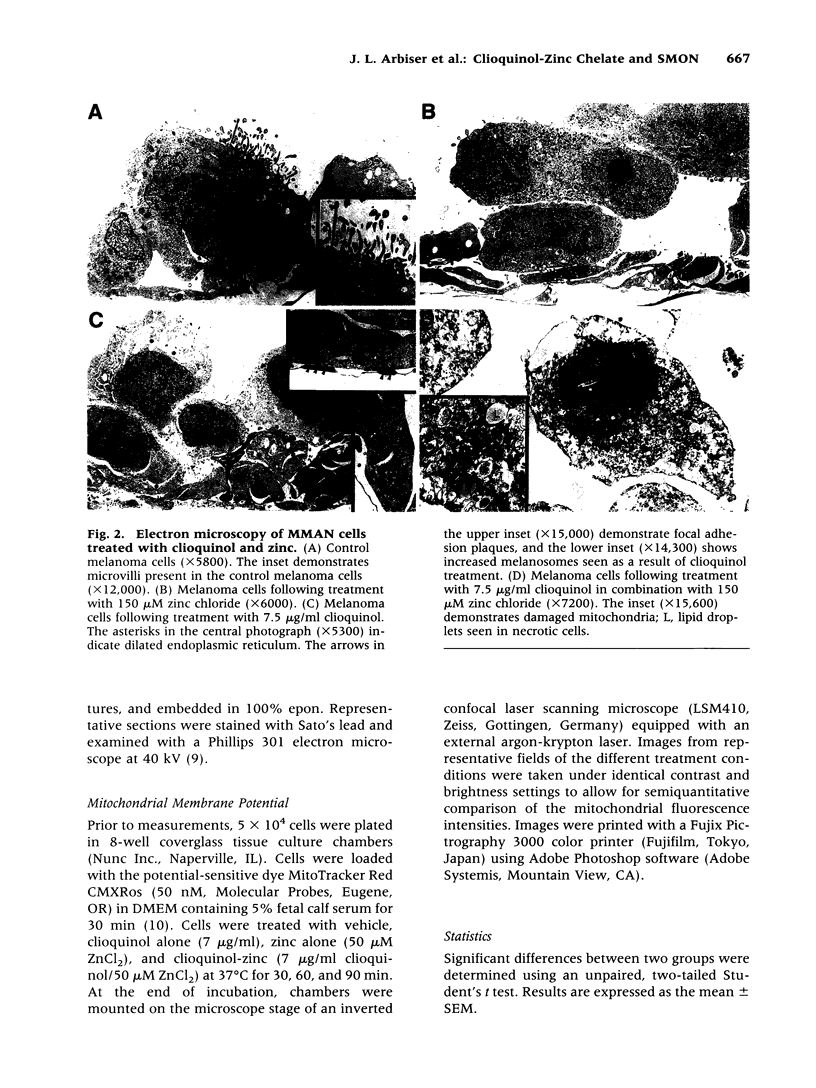
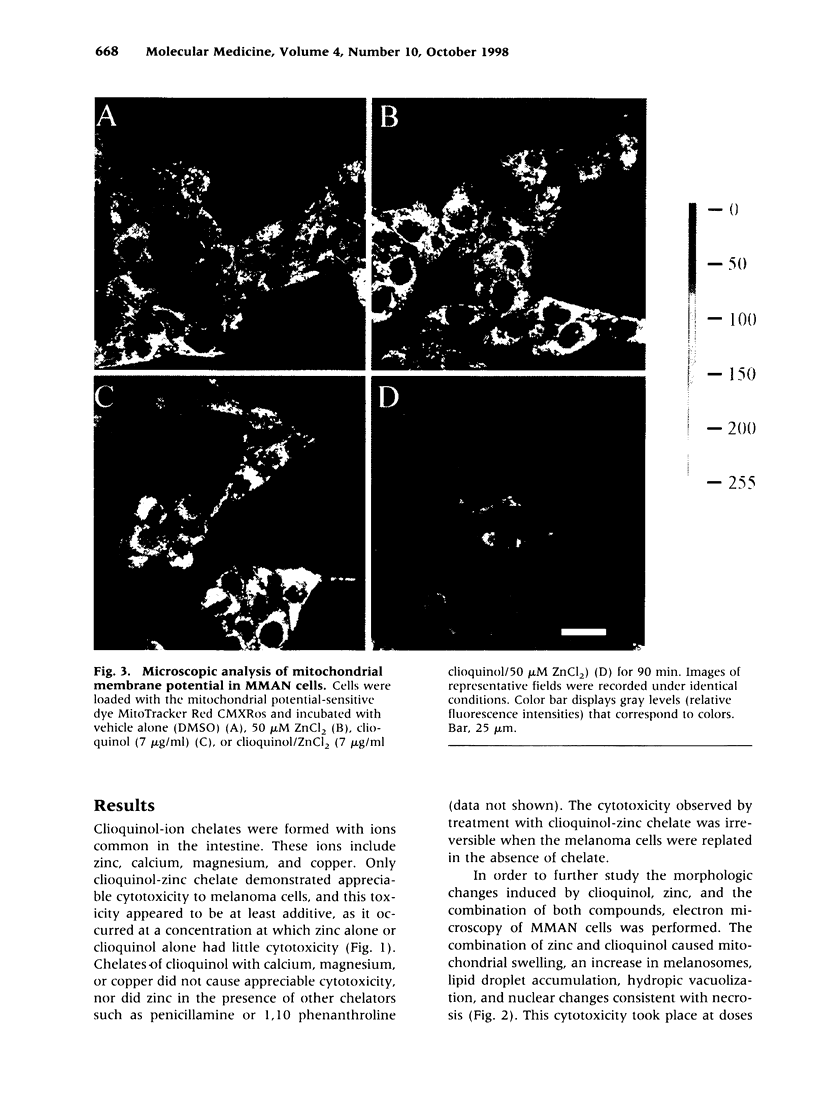
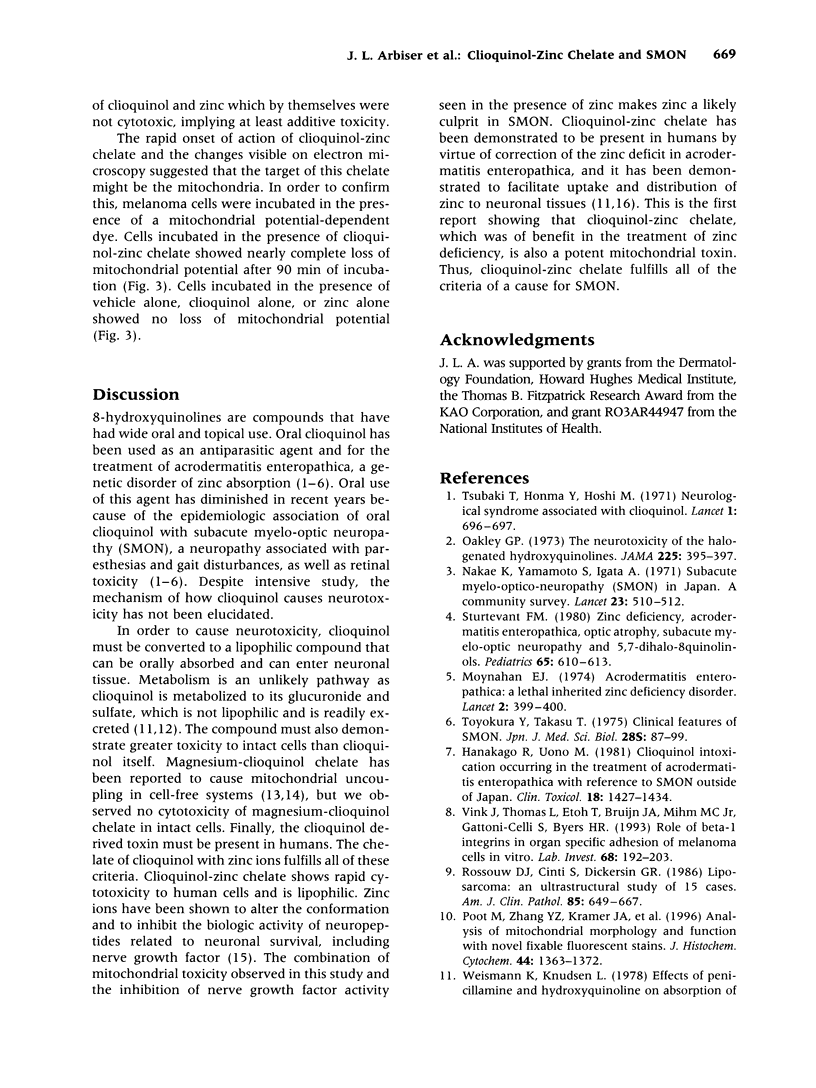

Images in this article
Selected References
These references are in PubMed. This may not be the complete list of references from this article.
- Hagihara M., Yagi K. Effect of albumin on uncoupling of oxidative phosphorylation by chinoform in rat liver mitochondria. Experientia. 1975 Sep 15;31(9):1069–1070. doi: 10.1007/BF02326965. [DOI] [PubMed] [Google Scholar]
- Hanakago R., Uono M. Clioquinol intoxication occurring in the treatment of acrodermatitis enteropathica with reference to SMON outside of Japan. Clin Toxicol. 1981 Dec;18(12):1427–1434. doi: 10.3109/15563658108990351. [DOI] [PubMed] [Google Scholar]
- Inouye B., Ogata M. Effect of chinoform on the function of biological membranes. Physiol Chem Phys. 1979;11(1):49–57. [PubMed] [Google Scholar]
- Moynahan E. J. Letter: Acrodermatitis enteropathica: a lethal inherited human zinc-deficiency disorder. Lancet. 1974 Aug 17;2(7877):399–400. doi: 10.1016/s0140-6736(74)91772-3. [DOI] [PubMed] [Google Scholar]
- Nakae K., Yamamoto S., Igata A. Subacute myelo-optico-neuropathy (S.M.O.N.) in Japan. A community survey. Lancet. 1971 Sep 4;2(7723):510–512. doi: 10.1016/s0140-6736(71)90436-3. [DOI] [PubMed] [Google Scholar]
- Oakley G. P., Jr The neurotoxicity of the halogenated hydroxyquinolines. A commentary. JAMA. 1973 Jul 23;225(4):395–397. [PubMed] [Google Scholar]
- Ohshima N., Kotaki H., Saitoh Y., Nakagawa F., Tamura Z. Sex difference of the metabolic disposition of clioquinol in rats. J Pharmacobiodyn. 1989 Jul;12(7):371–377. doi: 10.1248/bpb1978.12.371. [DOI] [PubMed] [Google Scholar]
- Poot M., Zhang Y. Z., Krämer J. A., Wells K. S., Jones L. J., Hanzel D. K., Lugade A. G., Singer V. L., Haugland R. P. Analysis of mitochondrial morphology and function with novel fixable fluorescent stains. J Histochem Cytochem. 1996 Dec;44(12):1363–1372. doi: 10.1177/44.12.8985128. [DOI] [PubMed] [Google Scholar]
- Ross G. M., Shamovsky I. L., Lawrance G., Solc M., Dostaler S. M., Jimmo S. L., Weaver D. F., Riopelle R. J. Zinc alters conformation and inhibits biological activities of nerve growth factor and related neurotrophins. Nat Med. 1997 Aug;3(8):872–878. doi: 10.1038/nm0897-872. [DOI] [PubMed] [Google Scholar]
- Rossouw D. J., Cinti S., Dickersin G. R. Liposarcoma. An ultrastructural study of 15 cases. Am J Clin Pathol. 1986 Jun;85(6):649–667. doi: 10.1093/ajcp/85.6.649. [DOI] [PubMed] [Google Scholar]
- Sturtevant F. M. Zinc deficiency, acrodermatitis enteropathica, optic atrophy, subacute myelo-optic neuropathy, and 5,7-dihalo-8-quinolinols. Pediatrics. 1980 Mar;65(3):610–613. [PubMed] [Google Scholar]
- Tjälve H., Ståhl K. Effect of 5-chloro-7-iodo-8-hydroxy-quinoline (clioquinol) on the uptake and distribution of nickel, zinc and mercury in mice. Acta Pharmacol Toxicol (Copenh) 1984 Jul;55(1):65–72. doi: 10.1111/j.1600-0773.1984.tb01963.x. [DOI] [PubMed] [Google Scholar]
- Toyokura Y., Takasu T. Clinical features of SMON. Jpn J Med Sci Biol. 1975;28 (Suppl):87–99. [PubMed] [Google Scholar]
- Tsubaki T., Honma Y., Hoshi M. Neurological syndrome associated with clioquinol. Lancet. 1971 Apr 3;1(7701):696–697. doi: 10.1016/s0140-6736(71)92699-7. [DOI] [PubMed] [Google Scholar]
- Vink J., Thomas L., Etoh T., Bruijn J. A., Mihm M. C., Jr, Gattoni-Celli S., Byers H. R. Role of beta-1 integrins in organ specific adhesion of melanoma cells in vitro. Lab Invest. 1993 Feb;68(2):192–203. [PubMed] [Google Scholar]




